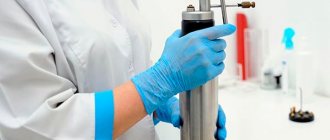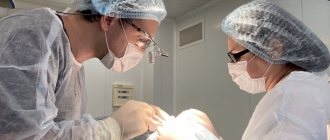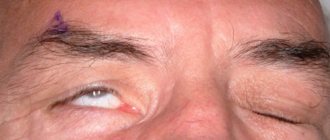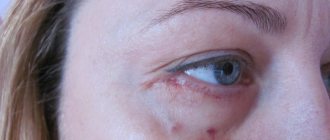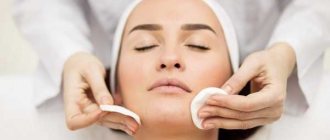Swelling after blepharoplasty is normal and common. This is the body's physiological response to tissue damage at the cellular level.
Swelling appears due to the release of plasma from the vessels into the tissue. It protects cells during the inflammatory response.
The severity of the swelling gradually subsides. The permeability of the walls of blood vessels decreases , and plasma stops leaking through them . To speed up recovery and minimize swelling, you need to follow the recommendations of doctors and take appropriate measures to eliminate them.
Formation of edema after blepharoplasty
The skin of the eyelids is the thinnest part of the body. Therefore, after surgery, bruises and swelling occur on it . The reason lies in the accumulation of fluid in injured tissues.
This result is possible even with an endoscopic procedure. A few millimeter punctures are enough to increase the permeability of blood vessels, compress the lumen and venous tissue, which prevent the normal outflow of blood and lymph.
We recommend reading: Rehabilitation after blepharoplasty
On the lower eyelids
Such a reaction cannot be avoided; perhaps only a change in severity. More extensive swelling appears after traditional blepharoplasty if transconjunctival intervention was performed - the congestion is not as pronounced, since the doctor touches fewer vessels during the operation .
On the upper eyelids
The dermis of the upper mobile skin is more vulnerable. The swelling after surgery is almost unnoticeable, but lasts longer because the area is less supplied with blood.
Puffiness occurs to varying degrees in each eye. A characteristic reaction also begins during endoscopic surgery.
The permeability of arterial vessels increases sharply, and moisture leaves the bloodstream into the interstitial space. The accumulated fluid puts pressure on the lumen of small veins and lymphatic vessels, creating an obstacle to the outflow of venous blood and lymph.
Sometimes the swelling spreads to neighboring areas - the area around the eyes, other areas of the face.
What should I do if the swelling or bruising lasts longer?
If traces after surgery persist longer, you can consult a doctor so that he can prescribe additional medications and cosmetics that will make it easier to eliminate the consequences of the operation.
However, it is important to remember that in the first days after blepharoplasty, swelling may increase slightly (this is a completely physiological process), but then it steadily decreases. The same goes for bruises. The blood that gets under the skin during the operation may be slightly redistributed; during the process of coagulation and resorption, the bruise can change not only its color, but also become a little wider. If this happens in the first days after plastic surgery, do not be alarmed.
By following the recommendations given and all the doctor’s advice, you can effectively speed up the process of disappearance of bruises and swelling.
Cost of eyelid surgery
How long does it take for swelling to go away after surgery?
Depends on how extensive the operation was. With blepharoplasty on the lower eyelids, swelling will go away within 7 days . Patient tolerance is of great importance.
Tissue renewal after surgery occurs within 60 days. Average rate of swelling resorption by day :
| 1–2 | The mobile upper integuments are swollen. Swelling of the lower eyelids practically does not cause any discomfort; it feels as if the person has been working for a long time and did not get enough sleep. The swelling of the upper mobile integument is more severe. Swelling gradually increases and reaches a maximum by the end of the second day. Hematomas appear, moving to the cheekbones. |
| 3–4 | The accumulated liquid begins to drain very slowly. Hematomas change shade from blue to greenish, brown, then yellow and become paler. Only the 10th part of the swelling goes away by the end of 4 days. |
| 5–7 | The swelling progressively subsides. Positive dynamics are noticeable, but it still reminds of a recent operation. The operation is noticeable to others; you cannot go outside without sunglasses, otherwise the swelling will increase. |
| 8–10 | On the 9th day a significant improvement was noticeable. On the 10th day of surgery, small swellings above the eyes and not completely resolved hematomas are visible. You can go to work. |
| 10–20 | There is still excess fluid, but the face looks normal. Almost imperceptible, but slight asymmetry of the face is visible due to varying degrees of swelling. You can use home remedies to reduce swelling. |
| 20–60 | During this period, the tissues are completely restored. The healing process is completed by 2 months. By the end of the first month, the swelling almost disappears, and in its place there appears slight redness and a slightly swollen scar. |
This schedule is used in the absence of disorders of the urinary and cardiovascular systems . If problems are present, swelling may last longer and be worse than in other patients.
The rate at which swelling decreases is affected by age, the thickness of subcutaneous fat, skin type (oily or dry), as well as the volume of intervention performed and technique.
What else can help?
From the fourth day, an antiseptic cream is usually prescribed. Experts advise using the drug "Traumel", which effectively fights against severe swelling after blepharoplasty. When the wounds have healed, a finger massage is performed with gentle tapping. At the same time, such drugs as “Contractubex” and “Hydrocortisone” are recommended, eliminating postoperative scars and scars. A faithful assistant is microcurrent therapy. It will stimulate lymphatic drainage, reduce localized inflammation, and improve bioenergetics/cellular metabolism. Swelling is also reduced by mesotherapy and lymphatic drainage massage.
Attention! Each treatment option should be discussed in consultation with your doctor. Indeed, in certain cases the use of the drug is necessary, but in others it is undesirable. To avoid complications, it is better not to self-medicate. If bruising/swelling persists after blepharoplasty for 10 days, immediately visit a plastic specialist. He will tell you what to do with eyelid swelling after blepharoplasty if it does not go away. Dysfunction of the lymphatic system is possible, requiring therapy against possible complications.
The doctor will explain what to do with swelling after blepharoplasty and will prescribe herbal remedies (Arnica, Bromelain, etc.). They are taken both after and before surgery, primarily to reduce postoperative bruises. In some studies, the effectiveness of such drugs is fully confirmed, in others, no noticeable improvements are noted. The anti-inflammatory substance here is helenalin and pineapple juice. Spinach, cabbage and other foods containing vitamin K increase blood viscosity and reduce blood leakage. Vitamins A, C, zinc, beta-carotene and copper also contribute to regeneration.
Transconjunctival blepharoplasty is a fairly simple operation. However, at first the picture is the opposite of the goal. At this stage, behind the bandages and bruises, the expected result is not yet visible. But you now know how to remove (reduce) swelling after blepharoplasty, speed up healing and thereby help your own appearance return to normal.
If the swelling does not go away
Medicines
To reduce swelling, antiseptic ointments are prescribed. It also disinfects fabrics . _ Traumeel and Sinyakoff work well. Bruises after using ointments will disappear in two weeks
Hydrocortisone ointment will also relieve swelling. It removes redness. Hydrocortisone ointment is placed inside and applied to the outside of the eyelids. On the second day, significant relief occurs, swelling decreases, and hyperemia disappears.
Diuretic tablets may be prescribed in combination with the ointment. They accelerate the removal of fluid from the body.
It is not recommended to use any medications in the first two days. During this period, swelling increases and can be redistributed. It is recommended to start using medications on the 3rd day.
Eyelid exercises and massage
Lymphatic drainage massage can speed up the disappearance of bruises and swelling. It is recommended to perform it in a beauty salon or visit your doctor . Doing it yourself is allowed, but not recommended. Lymphatic drainage massage accelerates postoperative healing of sutures.
Start gymnastics and massage no earlier than 10 days after surgery . The procedures allow you to activate the muscles and increase their tone.
Exercises:
- Close your eyes, open them wide and look at the farthest point in front of you. Don't strain your eyebrows. Only the eye muscles are involved in the exercise. Do 5 repetitions, if there is no pain or discomfort, repeat.
- Tilt your head back, look at the tip of your nose and return to the starting position.
Traditional methods
Cucumber will help relieve swelling . Cut the vegetable into thin slices and cool. Apply to closed eyes for 5–10 minutes. Chilled potatoes are used in the same way.
Rub the eyes with parsley decoction up to 3 times a day . It disinfects, removes redness, relieves swelling and promotes rapid tissue healing.
A chamomile compress relieves inflammation and reduces swelling at the same time. Prepare at the rate of 1 tbsp. l. for 200 ml of hot water. Do not pour boiling water, otherwise the medicinal herb will lose its healing properties. Sage decoction constricts blood vessels. It is recommended to apply it to the entire area around the eyes to prevent swelling from spreading. Sage is used to make cold compresses for the eyes.
Soak sterile gauze in the solution and apply to the eyelids for 10 minutes. Do not use cotton pads so that the fibers do not get caught on scars that have not completely healed.
Causes of bruising and swelling
During surgery, the blood vessels around the eyes are damaged. This leads to the formation of bruises - blood accumulations. The body sends more plasma to the site of injury. This process creates swelling.
Bruises after blepharoplasty go away in about 7-10 days. The swelling begins to decrease approximately from the third day after surgery.
Immediately after surgery, the bruise has a pronounced red color. Then the redness darkens, turning dark purple. Then the disturbed area begins to turn yellow. The last stage can last up to 8 weeks. This is due to the individual characteristics of the patient.
Doctors' recommendations
A list of tips from plastic surgeons to quickly eliminate the side effects of blepharoplasty:
- Place your head on an elevated surface for 1 week. This will improve blood flow from the eyes and will not allow accumulated fluid to stagnate.
- Drink less fluid during the rehabilitation period. Avoid alcoholic drinks, coffee and tea. Energy drinks also increase blood flow to the head.
- Reduce physical activity and do not perform work that requires bending your head.
- Wash your hair carefully, avoiding getting soap and tap water into your eyes. Tilt backwards, not forwards.
- Avoid exposure to direct sunlight for the first week.
- Check hormonal balance. It also affects swelling, along with air pressure.
- Avoid activities that require you to blink frequently. For example, reading, watching TV, working at a computer for long periods of time, or wearing contact lenses.
- Do not use antibacterial, antiseptic or anti-inflammatory ointments without the approval of your doctor.
Sanding restores and masks the seam faster. It is recommended no earlier than 2 months after surgery. The procedure does not remove swelling. Many cosmetologists give such information in order to earn more money.
Sanding does not remove swelling, but causes it. After the procedure, the swelling is small and goes away after 7 days. It removes the top layer of skin, smoothes the surface of the eyelids and suture areas. After resurfacing, scars are not so noticeable. After 1 course they disappear.
Doctor's advice
From the table you will find out how long swelling lasts after blepharoplasty, as well as what advice the doctor gives. Daily instructions on how to relieve swelling after eyelid surgery are gradually becoming less stringent.
| Number of days | Doctor's recommendations |
| 1 | In hospitals, procedures must be performed by a nurse. At home, it is necessary to reduce activity as much as possible, apply cold and treat the skin with special preparations. |
| 3 | It is allowed to take a shower and wash your hair without getting shampoo and water in your eyes. Frequent blinking should be avoided. |
| 6 | Medical stickers or stitches are removed. The swelling (normally) begins to subside. At this stage, not following the doctor’s recommendations can significantly aggravate the situation. |
| 10 | It is allowed to resume using contact lenses and start working on a PC, but without overworking. |
| 14 | You can apply eye shadow and mascara, but only those intended for sensitive skin. |
| 15-60 | You are allowed to sleep in any position and gradually increase physical activity. The surgeon prescribes physiotherapy sessions and medications. |
How to reduce swelling yourself
To relieve eye swelling after blepharoplasty or to make it less pronounced, an effective method of preparing for the session has been developed. To begin with, 7 days before surgery, you need to quit smoking and drinking alcohol. You should stop taking blood thinners (anticoagulants) in advance. Reduce salt intake: it helps retain moisture in tissues. Also, contact only qualified surgeons who are proficient in the latest methods of atraumatic correction with minimal likelihood of complications.
Cold in the form of ice is the most powerful anti-inflammatory agent. Doctors recommend treating the wound with cold almost immediately after the end of anesthesia. In this case, you should not bow your head or suddenly change the temperature of the affected area. During the first 48 hours, ice packs help reduce pain after upper eyelid blepharoplasty and the swelling itself. Ice is applied to the cheeks and eyelids, at intervals of 30 minutes while awake, and kept for 20 minutes - the skin should become cool to the touch. Cold is not applied at night.
Here are some rules to help reduce swelling:
- do not drink alcohol, do not smoke - especially carbonated alcoholic drinks are prohibited;
- avoid any physical stress, rest more, relax - at first you should not lift weights exceeding 4 kg;
- at night, lie on your back, with a high pillow under your head, preferably half-sitting;
- during the two-week postoperative period, wash your hair, as in hairdressers, throwing it back;
- eliminate activities that cause frequent blinking - working at a PC, watching TV, reading in a dimly lit room;
- maintain water balance, without significant deviations from the norm;
- At first, avoid being in the sun;
- give preference to healthy light foods;
- Swelling is also affected by air pressure and hormones.
Sometimes a sunken eye effect may occur; structured fat grafting is used to correct it.
Contraindications for carrying out
Surgery is always stressful for the body. There is a list of contraindications for blepharoplasty, non-compliance with which can lead to health problems:
- diabetes;
- liver diseases;
- cancerous tumors;
- diseases of the cardiovascular system;
- increased intraocular and blood pressure;
- disorders in the endocrine system
The rehabilitation period can take place in different ways. It is especially difficult for patients with weakened bodies. In this regard, this operation is prohibited:
- if you have HIV;
- people who have recently had a heart attack or stroke;
- suffering from hepatitis
- pregnant and lactating women;
- minors
During the recovery period, infections and respiratory diseases can cause serious complications. Therefore, before blepharoplasty, they need to be completely eliminated.
If the patient suffers from chronic diseases of the internal organs, consultation with related specialists is mandatory, who must approve the operation.
Care after blepharoplasty of the upper and lower eyelids
After blepharoplasty, patients are prescribed various medications (for example, antibiotics) and undergo physiotherapeutic treatment (lymphatic drainage massage, microcurrents, electrophoresis and ultrasound) for quick recovery.
The speed of rehabilitation after blepharoplasty depends on proper care of the surgical area. It includes a set of measures affecting the skin of the eyelids, suture lines and eyes. It’s worth looking at this in more detail:
seam care
Immediately after the operation, a special patch is glued to the suture area - strips, which act as a protective bandage. They are removed after 5-7 days. For a week, it is necessary to treat the suture line with antiseptics, for example, an alcohol solution of chlorhexedine and apply cool lotions with furatsilin 5-6 times a day for 15 minutes, 3-4 days, then less often, 3-4 times a day (you can use cool bags of brewed tea, medicinal herbs - chamomile, St. John's wort).
eye care
The eyes are not injured in any way during the operation, so they do not require special care. However, wearing lenses is avoided to avoid causing irritation. Very often after blepharoplasty, symptoms in the eye area such as irritation, itching, dryness and redness may be observed.
If the above symptoms occur, you must use special eye drops. They will help you quickly and painlessly get rid of unpleasant manifestations. The most common drugs include:
- Artificial tear;
- Tobrex;;
- Systane.
upper and lower eyelid care
pursues the following goals:
- protects seams from contamination
- accelerates the resolution of edema
- stimulates the wound process and rapid healing
In addition to the recommendations of the plastic surgeon, in the postoperative period, you can perform a special set of exercises for the eyes, which is necessary to improve blood supply to the surgical area, to accelerate the resolution of swelling and reduce the inflammatory process.
Self-massage also helps in restoring the periorbital area. The essence of the massage is that point circular pressure is applied with the fingers in the eyelid area.
Ointments and creams
External remedies will help get rid of unpleasant symptoms after surgery. Effective drugs for eliminating hematomas are:
- Indovazin;
- Traumeel S;
- Lyoton;
- Hydrocortisone;
- Lokoid
To eliminate itching and speed up healing, you can use Inferase or Blepharogel cream. To ensure that the scar after surgery is smooth and soft, and the fibrous tissue does not grow, you can use the following means:
- Contractubex;
- Kelofribase;
- Dermatix;
- Clearvin
